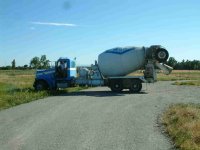Before I decided on a spec. for the new road I've installed on my property, I did two things. The first was get in touch with a couple of local contractors and ask them to recommend a spec.for my area. The second was to review the benefits of using a geotextile separating membrane.
Soil conditions here are clay and each of the contractors came up with a similar spec. I generally followed their advice but added the geotextile membrane after talking to a couple of the manufacturers of these products. I used two of the local contractors to run in the material I needed but did my own excavation, spreading and consolidation. Here's the final road build up.
1 Excavate and remove all organic matter and topsoil (in my case 12 - 16");
2 Lay geotextile separating membrane;
3 Spread and consolidate approx 8" of overs (rocks from 3 - 6" in size);
4 Spread and consolidate approx 3" of pit run ( mainly gravel fines);
5 Top with 2" of crushed rock.
The separating membrane prevents the clay from pumping up into the overs, which it would over time, causing ruts and depressions. Depending on your soil, the separating membrane might not be necessary.
Each of the contractors recommended I start with the overs to provide a good, free draining base. The pit run topping binds the overs and prevents any movement in the base. I might have been able to use smaller rocks for the base than the overs but the cost of smaller material would have been much the same and I decided to opt for material that would be as free draining as possible. Maybe with overs the size I used I could have got away without the geotextile membrane but I figured it wasn't worth the risk. The nuisance and cost of continually trying to fix a badly spec'd road would cost a lot more than the geotextile fabric did.
I've only laid one load of the crushed rock topping so far - I wanted to try a sample before I decided if this is what I wanted to use as the wearing coat. It's worked well and I'll top the rest of the road once I finish the construction works for the house and barn.
We're already run 40 ton, ten wheelers up and down the road and so far we've suffered no ruts or depressions despite wet weather so I'm pretty confident the road will perform well long term.
Maybe what I have is overdesigned but the material costs haven't been that much. Excluding diesel and tractor time, I've spent around $3,000 CAN so far for a 12 feet wide road 220 feet long. With any construction in the ground, it's necessary to get it right first time because if you don't, fixes tend to be disruptive and expensive. I've another 150 feet or so to construct but already have the geotextile fabric for it so reckon I have to spend about another $1k CAN on materials before we're through. This excludes the crushed rock topping.
